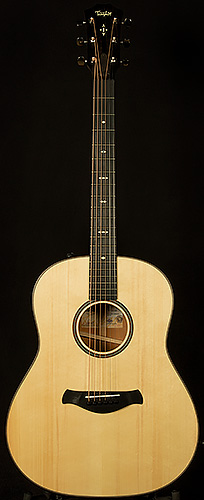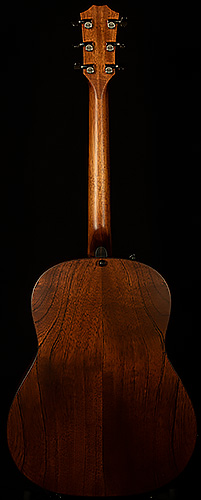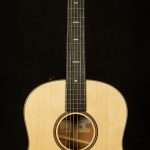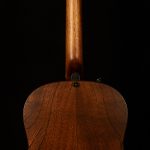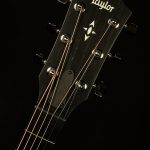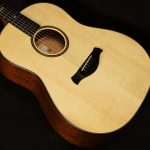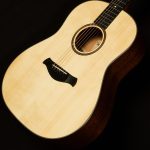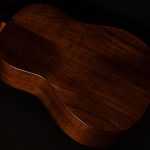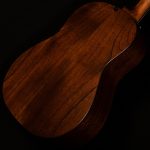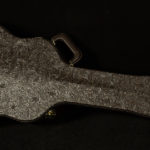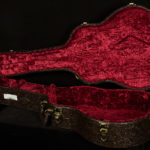Used Taylor Grand Pacific Builder’s Edition 517e
Condition Report
This gently-used Taylor is in dreamy condition as it shows hardly any signs of use with no cosmetic flaws to report. It has a full manufacturer's warranty, as it has never been registered, and it looks basically new. It comes with its original hardshell case, too!
The Grand Pacific: A Modern Classic
Wildwoodians, we are proud to present the latest guitar to emerge from Taylor design maestro Andy Powers's workshop: the Grand Pacific dreadnought. Simply put, this new round-shouldered beast is one of the most inspiring new guitar designs to emerge in the last decade. Though many of Taylor's classic cornerstones inform its design, the Grand Pacific sounds and feels like nothing else in their entire line. It's revolutionary, it's bold, it's fresh, it's imaginative, and above all, it is sure to inspire you to reach new heights on your journeys across the fretboard. I (Trevor, the resident Wildwood Guitar Scribe) would like to cordially invite you to journey down the rabbit hole with me and learn a bit more about what makes the Grand Pacific so spectacular.
California Dreamin'
Before we get into the specific delights the 517e has to offer, let's take a step back and talk about what the Grand Pacific body style is and what benefits it offers the player. I was lucky enough to learn straight from the source, because our friends at Taylor were kind enough to fly me out to San Diego to visit their factory in El Cajon and learn about the Grand Pacific from Andy Powers himself.
Andy Powers is everything you'd hope him to be. He brims with warmth and intelligence, and he is a truly fearsome guitar picker. After setting the fretboard ablaze as he put a Grand Pacific through its paces, he shed some light on what inspired him to build the guitar in the first place.
While Andy was doing a bunch of work on his new home, he found himself listening to a lot of classic acoustic music: bluegrass, country, and folk. Now, Andy was a renowned repairman before he started work at Taylor. Though he's too modest to name names, he personally worked on many historic guitars that made appearances on iconic records. As he listened to these albums, he reflected on the time he spent with these classic instruments. Oddly enough, many of them left him wanting something more when he sat down with them. They just didn't sound like the record! Why? The wheels in Andy's head started turning, and he started dreaming. How could he design an acoustic guitar that sounded like a record in the room? The seed that would grow into the Grand Pacific began to sprout.
The Birth of V-Class
To tell the story of the Grand Pacific, we have to pick up the story of V-Class bracing. Though V-Class bracing made its commercial debut in Taylor's Grand Auditorium guitars, Andy Powers actually came up with the idea for the Grand Pacific. V-Class bracing is truly revolutionary, and it is one of the reasons for the Grand Pacific's greatness.
You see, for years acoustic guitar builders had to compromise between volume and sustain. Flexibility equals volume, and stiffness equals sustain. Obviously, a piece of wood cannot be rigid and flexible at the same time, so builders had to go for one or the other.
Andy Powers wanted to have his cake and eat it, too. After much tinkering, V-Class bracing was his elegant solution to the problem that has plagued luthiers for centuries. As the name implies, V-Class bracing features two long pieces of wood that make a "V" shape together. The bracing is quite thin and flexible near the rear bout, but it becomes thicker as you get closer to the soundhole.
So, you get volume from the flexible parts of the bracing, and sustain from the rigid parts! Many areas of the guitar neck that typically sound weak (ninth fret on the G string, for instance) have just as much presence, resonance, and sustain as the low E. As a result, the Grand Pacific sounds supremely balanced.
Intonation Station
V-Class bracing also does wonders for the guitar's intonation. Are you ready to have your mind blown? When I was in El Cajon, Andy explained that an acoustic guitar's intonation is not necessarily just the sum of the typical adjustments like saddle height, nut slots, and neck angle (though they do play a part). The way that the actual guitar itself vibrates also has a lot to do with how in-tune it sounds.
Andy told me to picture it like this: when you take close-up slow-motion footage of a guitar's top with a high-speed camera as someone plays it, you can see the top move vividly. On a traditional X-braced guitar, the top vibrates in a disorderly, disjointed manner. This can cause a guitar with the perfect saddle height and neck angle to sound out of tune when you play a big open chord.
By contrast, guitars with V-Class bracing vibrate in a much more orderly manner. The graduated braces compel the energy from the player's attack to move from the thin outer part of the bracing to the thicker inner part in an efficient manner. If you were to take a high-speed shot of a V-Class top, you would see it rock back and forth evenly. Because of that V-Class magic, the Grand Pacific sounds so in-tune that it's scary.
A Metaphor for Monster Sound
So, how does V-Class bracing sound in the context of a classic dreadnought? Andy loves to talk in metaphors, and he shared one really crystallized my understanding of the Grand Pacific's tone. Imagine a six-lane highway with six cars traveling side-by-side in their respective lanes. That's how a Grand Auditorium with V-Class bracing sounds. You can hear each note ring out pure and clear with excellent separation.
The Grand Pacific's is more like six boats traveling side by side. Though the boats don't crash into one another, their wakes interact behind them. When you strum all six strings on a Grand Pacific, the notes "run together" and blend in a way that is symmetrical and orderly but also warm and inviting. Andy kept calling it a "seasoned" sound, and that's an apt description. The notes bleed into one another and form beautiful vivid, colorful timbres.
Post-Production Magic
The reason why most of the iconic guitars Andy repaired left him feeling disappointed is simple: a lot usually happens to acoustic tracks in post-production. Typically, a mixing engineer will use an EQ to roll off woofy low end and cut other "problem frequencies" that sound ugly. They'll then use a compressor to round off the attack, and a limiter to kill any remaining transients. So, that guitar that sounded gloriously rich in the room during the recording winds up sounded sculpted and well-mannered on the actual record. Thanks to its V-Class bracing, the Grand Pacific sounds like much of this post-production work is already done as you play it live in the room.
Here's the best way to explain it, again courtesy of the illustrious Mr. Powers. Put an open palm in front of your mouth and say "PUH PUH PUH PUH PUH" repeatedly (don't do this in public or you will look foolish). Then say "MM MM MM MM MM" into your palm. Typical dreadnoughts make that "PUH" noise upon attack as woofy low-end escapes the soundhole. The Grand Pacific makes more of a "MM" sound. It may not rattle your rattle your ribs, but it does sound awfully nice—iconic, even.
Therein lies both the rub and the magic with the Grand Pacific: though it has plenty of muscle and power, it doesn't necessarily sound like a wooden piano in the room. It sounds produced, and there's a big difference. For that reason, it's not going to replace your J-45 or your D-18. Big-sounding, boomy acoustics are a lot of fun, and we love them, too. The Grand Pacific just presents a whole new flavor of acoustic tone that is different but equally enticing. Playing one feels like stepping into a classic record that hasn’t been made yet.
Add it Up
So, what does it all add up to, sonically? The Grand Pacific sounds warm, seasoned, and inviting like a classic dreadnought as warm overtones swirl together and mix to form a truly spectacular collage of sound. But, V-Class bracing also gives it a spectacular combination of volume and sustain. Furthermore, V-Class bracing helps sculpt the Grand Pacific’s frequency response to sound balanced and mannered. Not to mention, it helps give the Grand Pacific astoundingly accurate intonation. So, to sum things up: the Grand Pacific is a warm, vintage-style dreadnought with improved volume, sustain, balance, and intonation. I don’t know about you, but I’ll trade a little bass boom for all that any day of the week!
The Delights of Adirondack Spruce
Here at Wildwood, we love Adirondack spruce the way the narrator of the Percy Sledge song "When a Man Loves a Woman" loves the titular woman: fervently, and with our whole heart.Adirondack spruce has a few inspiring signature sonic quirks, and we love the way it adds flavor when used for bracing. But first, a crash course in headroom: every acoustic guitar top has a point at which it can't get louder. When an acoustic guitar reaches this point, the guitar starts becoming more and more compressed as the player hits harder. The longer it takes for a guitar to reach this point of compression (I like to call it The Point of No Return), the higher its headroom.
Furthermore, Adirondack spruce bracing tends to impart a woody, percussive quality to the guitar's attack. Subtle right-hand dynamics come through with exceptional fidelity and detail, but it's not a sterile sort of hi-fi sound. So, this guitar has a clear, organic, bold attack that asserts itself with incredible power.
Smitten With the Builder’s Edition
This particular model is a Builder’s Edition 517e. As with all the other Builder’s Editions, it has a host of luxurious appointments. A thin “silent satin” finish maximizes resonance while reducing incidental noise, while chamfered body edges, a ridgeless neck heel, and contoured fingerboard edges maximize the player’s comfort. It also sports a compound-carved neck profile that makes for natural handfeel all the way up and down the fretboard. Factor in the round, warm tone produced by the mahogany back and sides, and you get an intoxicating sonic cocktail full of vintage flavors. We’re proud to present such an amazing instrument, and we know the Grand Pacific Builder’s Edition 517e will bring you a lifetime of joy and inspiration throughout all your acoustic adventures.
Specifications:
| Brand | Used |
|---|
| Model | Taylor Builder's Edition 517e |
|---|---|
| Type | Grand Pacific |
| Top Wood | Solid Adirondack Spruce |
| Top Finish | Silent Satin Natural |
| Bracing | V-Class |
| Back & Sides Wood | Solid Neo-Tropical Mahogany |
| Back & Sides Finish | Silent Satin |
| Body Binding | Sapele |
| Neck Wood | Tropical Mahogany |
| Neck Profile | Compound Carve |
| Neck Dimensions | .860 1st - .940 9th |
| Neck Finish | Satin |
| Fretboard Material | West African Crelicam Ebony |
| Fingerboard Inlays | Grained Ivoroid Arrowheads |
| Scale Length | 25.5" |
| Nut Material | Black Graphite-Infused Tusq |
| Rosette | Single-Ring Black Sapele and Maple |
| Electronics | Expression System 2 |
| Tuners | Classical Nickel |
| Bridge | West African Crelicam Ebony |
| Saddle | Micarta |
| Case | Taylor Western Floral Hardshell Case |
| UPC | 00887766093848 |
Why Order from Wildwood Guitars?
An instrument from Wildwood isn't just an ordinary guitar. It's your guitar. Each and every instrument we sell includes a full, point by point setup, an exhaustive evaluation, and expert shipping procedures, with first class, industry leading standards from start to finish. Why? Because you deserve it.Click Here to learn more about what makes a Wildwood instrument so special...


